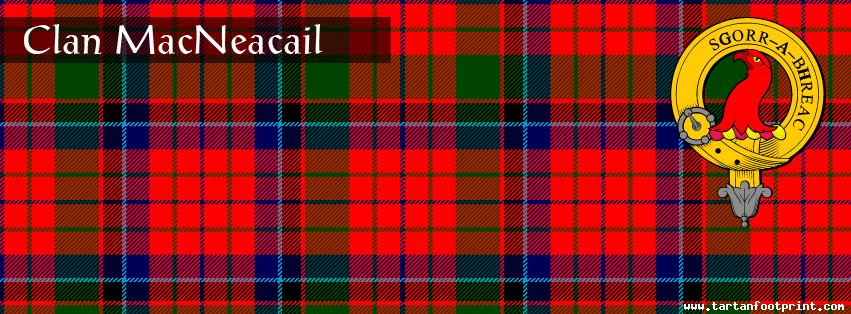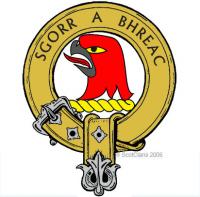
Clan MacNeacail (McNicol)
Originally known as Mackrycul and then MacNicol and then later MacNeacil. The origin of the name Mac Neacail in (Gaelic means "Son of Nicol". The MacNeacils are believed to be of Norse and Viking origin with their name also being frequent in Scandinavia.
It is believed that the MacNeacails formed part of two large Viking bands which ravaged the east coast of England and formed colonies under the names of Nicholl and Nicholson in Northumberland and Cumberland. They also spread to the area in Scotland now known as Argyll and are said to have sent warriors to participate in the tribal wars in Ireland. Some members of the clan settled in the north of Ireland where their descendants can still be found today.
The first MacNeacail chief on record in Scotland was John, son of Neacal in the early fourteenth century. He appears in the company of leading Hebridean chiefs, Macdonald, Macdougald and Macruairi, descendants of Somerled, who had wrested control of the southern Hebrides.
in the 14th century during the Wars of Scottish Independence the Clan MacNeacil fought against the English for King Robert I of Scotland at the Battle of Bannockburn in 1314.
The Clan MacNeacail are known to have supported the Clan Donald and their chief who was Lord of the Isles. The MacNeacils were considerd important enough to sit on the MacDonald's council.
Courtesey of Wikipedia
Clan History Courtesy of Clan MacNicol Society
Clan MacNeacail (MacNicol) has a long and proud history of over 800 years in the Hebrides and Western Highlands. The Chief, MacNeacail (MacNicol or Nicholson) of Scorrybreac, took his designation from his land near Portree on the Isle of Skye. The islands of Lewis and Skye remained part of the Scandinavian kingdom of Mann (the Isle of Man) and the Isles, under the suzerainty of Norway, until 1266. It seems likely that, like the MacLeods of Dunvegan, the MacNicols are of mixed high Norse and Celtic descent. Study of ancient record sources show that clan MacNicol was the earliest celtic clan to inhabit the northern Hebrides.
The name-father of the Clan, Nicail or Nicholas, a name popular in Scandinavia, must have flourished in the mid-13th century. The MacLeods of Lewis appear to have inherited or confiscated their considerable possessions through marriage with a MacNicol heiress in the 14th century. The ancestral Nicail, therefore, probably lived in Lewis, where he and his ancestors would have served the kings of Mann and the Isles in a mixed Norse and Gaelic environment.
The first MacNicol on record, early in the 14th century, is John, son of Nicail. He appears in the company of leading Hebridean Chiefs, the MacDonald, MacDougall and MacRuairi descendants of Somerled (d. 1164), who had wrested control of the southern Hebrides from the king of Mann. John was perhaps the leading man on Lewis.
At the seige of Carrickfergus Castle in Ireland in 1316, MacNicol and his spearmen supported Edward Bruce, brother of Robert the Bruce and High King of Ireland, against the English.
In the next generation, most of the MacNicol lands passed to the Lewis MacLeods, but the male line of the MacNicols continued, finding a home in the Trotternish peninsula of Skye.
Later in the Middle Ages the MacNicols followed the MacDonald Lords of the Isles and sat on their council. In 1540, James V, King of Scots, landed at Portree during a naval expedition, and tradition maintains he was entertained at Scorrybreac. Another tradition is that Bonnie Prince Charlie, fleeing after the defeat of the Jacobites at Culloden, was hidden overnight in a cow-shed by the then Chief.
In the 19th century, the Nicolsons were badly afffected by the Highland Clearances. (MacNeacail was anglicized to Nicolson when speaking in English in the mid-17th century). The Chief was forced to abandon Scorrybreac, and his family settled in Tasmania, where the present Chief was born. Clansmen were evicted from their crofts and also sought refuge in emigration, Prince Edward Island being a favoured destination.
Over the centuries, Clan MacNicol has given the world numerous poets and preachers, writers and warriors, historians and heraldists. The greatest Gaelic poet of modern times, Sorley MacLean, was a Nicolson on his mother’s side. Oral tradition in his family has preserved some Nicolson songs of considerable antiquity and great beauty.
Ben Chracaig and the Isle of Skye
In 1987, part of our original clan property was for sale. Within nine months, the world-wide Clan raised the entire amount to purchase the 130 acre Ben Chracaig (ben crak-aig) property. The wildly beautiful spit of land juts out into the Sound between Skye and Raasay just above Portree. It encompasses the legendary Piper’s or MacCoiter’s Cave.
The Clan has continued to raise funds to rebuild the nature trail along the cliffs and improve the property as park land. The control of the property and funds has been placed in perpetual trust under Urras Clann MacNeacail with a group of Clan members living on Skye as property managers. The North American membership has established the Scorrybreac Fund, Inc. To continue the fund raising effort, not only for Ben Chracaig, but for other projects of historical importance to the Clan.
The clan has also had a campaign to replant some groves of trees on Ben Chracaig; funds we raised were matched by the Countryside Commission in Scotland. We have supported access improvements to and restoration of St. Columba’s Isle, an ancient center of the Church in the west of Scotland about 6 miles from Portree, where reputedly many Chiefs of the clan were buried.
Clan MacNicol Societies
Each Clan MacNicol society (Australia, North America, Scotland, etc.) publishes newsletters (usually quarterly) with information exchanged through these publications. Our societies actively participate in Scottish functions with Clan Hospitality/Recruiting tents at various Scottish Games or Festivals throughout the year. Members are invited to partake of Clan hospitality wherever MacNicol tents are set up.
Members throughout the world have demonstrated a willingness to help and advise other members in various ways, including travel plans, genealogical research, etc. The Annual Clan Meeting and Gathering is held in various countries (Scotland, Australia, Canada, USA, etc.) on a rotating basis.
The Clan MacNicol societies are members of The Highland Clan MacNeacail Federation to which a coat of arms has been granted. The Federation is a Founder of the Museum of Scotland.
The Motto
The Clan motto: Scorrybreac which was also the clan war cry. Like the MacFarlanes it was the prominent land feature on the clan lands where the Chiefs home and great hall were for over 800 years on the Isle of Skye near Portree. The exact translation into English would be Speckled Rocky Upland. Other mottos are taken from various Gaelic translations such as Generositate non Ferositate which in the Gaelic proverb about the clan is exactly translated as The Nicolson/MacNicols are not revengeful. The Motto under the clan shield is translated Remember but Look Ahead.






